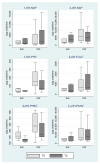Biomonitoring of Hydroxylated Polycyclic Aromatic Hydrocarbon Metabolites in Workers at a Waste-to-Energy Incinerator, Turin, Italy
- PMID: 39857530
- PMCID: PMC11764491
- DOI: 10.3390/ijerph22010077
Biomonitoring of Hydroxylated Polycyclic Aromatic Hydrocarbon Metabolites in Workers at a Waste-to-Energy Incinerator, Turin, Italy
Abstract
This paper presents the results of the human biomonitoring of ten urinary OH-PAHs (hydroxylated polycyclic aromatic hydrocarbon) in a cohort of workers at an incinerator in Turin, Italy. Long-term exposure was assessed through repeated measurements at three time points: before the startup (T0), after 1 year (T1), and after 3 years (T2). Paired data were available for 26 subjects, seven administrative workers (AWs) and 19 plant workers (PWs). Short-term exposure was assessed by comparing start-end shift measurements. Due to the non-normal distribution of the data, the nonparametric Cuzick's test for trend and the Wilcoxon signed-rank test for paired samples were used. Neither the trend nor the T0-T2 comparison tests resulted in statistically significant outputs in the two groups (q-value > 0.05), even when controlling for smoking habits. In relation to PWs, some of the metabolites were higher at T2 with respect to T0, but no linear increase was found. Conversely, 1-OH-PYR (ng/g creatinine) showed lower median values at T1 (61.5) and T2 (67) compared to the baseline (151.3). Similarly, short-term comparisons yielded no significant results, with rather overlapping distributions of values. Overall, no significant increases in metabolite levels were detected as a result of occupational exposure in the incinerator workers considered. These findings align with previous results for metals and ambient air measurements.
Keywords: exposure biomarkers; longitudinal study; occupational exposure; polycyclic aromatic hydrocarbons; waste-to-energy plant.
Conflict of interest statement
The authors declare no conflicts of interest. The funders had no role in the design of the study, in the collection, analysis, or interpretation of the data, in the writing of the manuscript, or in the decision to publish the results.
Figures

References
-
- Bena A., Orengia M., Cadum E., Farina E., Alimonti A., Bocca B., Chiusolo M., De Felip E., Gandini M., Iamiceli A.L., et al. Biomonitoring and exposure assessment of people living near or working at an Italian waste incinerator: Methodology of the SPoTT study. Environ. Monit. Assess. 2016;188:607. doi: 10.1007/s10661-016-5624-5. - DOI - PubMed
-
- Bena A., Chiusolo M., Orengia M., Cadum E., Farina E., Musmeci L., Procopio E., Salamina G., Gruppo di lavoro SPoTT Population health surveillance of the general population living near Turin (Northern Italy) incinerator (SPoTT): Methodology of the study (Sorveglianza sulla salute della popolazione nei pressi del termovalorizzatore di Torino (SPoTT): Presentazione del programma di sorveglianza) Epidemiol. Prev. 2016;40:366–373. doi: 10.19191/EP16.5.P366.112. - DOI - PubMed
-
- WHO (World Health Organization), Regional Office for Europe Population Health and Waste Management: Scientific Data and Policy Options: Report of a WHO Workshop: Rome, Italy, 29–30 March 2007. [(accessed on 19 December 2024)]. Available online: https://iris.who.int/handle/10665/107871.
-
- Bocca B., Bena A., Pino A., D’Aversa J., Orengia M., Farina E., Salamina G., Procopio E., Chiusolo M., Gandini M., et al. Human biomonitoring of metals in adults living near a waste-to-energy incinerator in ante-operam phase: Focus on reference values and health-based assessments. Environ. Res. 2016;148:338–350. doi: 10.1016/j.envres.2016.04.013. - DOI - PubMed
MeSH terms
Substances
Grants and funding
LinkOut - more resources
Full Text Sources
Medical

